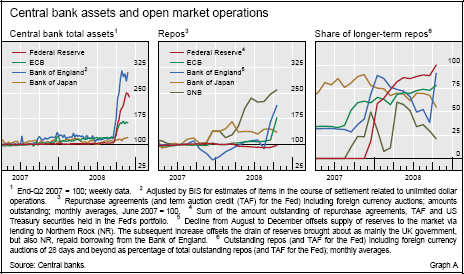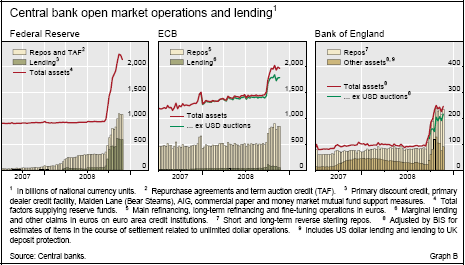Central bank balance sheets
(Extract from pages 18-19 of BIS Quarterly Review, December 2008)
Central banks in major advanced economies have taken a wide range of actions to address the tensions in the interbank and money markets since August 2007. As a result the size, composition and risk profile of their balance sheets have changed substantially. Major central banks have provided more term funding to a wider range of institutions and against wider collateral than in the past. In some cases, they stepped in to provide direct lending to distressed institutions and took other exceptional measures to improve funding conditions in credit markets. This box outlines how these actions have affected central bank balance sheets.
During the initial stages of the turmoil, until mid-September 2008, central bank measures did not lead to a significant expansion of the size of their balance sheets. However, there was a major shift in the composition of their assets, as central banks conducted, in general, more frequent and longer-term liquidity-providing operations than in the past (Graph A). In some cases, they also broadened the range of eligible collateral.
In the United States, the Federal Reserve (Fed) lengthened the maturity of its refinancing operations. Their size also increased, but this was offset by the shrinking of its portfolio of Treasury securities. In addition, an increasing share of the latter was lent to primary dealers against a wide range of less liquid securities to help liquefy their balance sheets via the Fed's Term Securities Lending Facility (with no net impact on bank reserves or on the size of the central bank balance sheet). Similarly, the Bank of England (BoE) allowed banks to swap less liquid securities against more liquid ones under its Special Liquidity Scheme. The BoE, European Central Bank (ECB) and Swiss National Bank (SNB) substituted longer-term open market operations (OMOs) for shorterterm operations. While the ECB and SNB established swap lines with the Fed to distribute dollar liquidity to European banks, the amounts involved were relatively limited, and there was little or no use of central bank standing lending facilities.
After the failure of Lehman Brothers, the balance sheets of several major central banks expanded sharply, reflecting their growing intermediation role in money markets. The assets of the Fed and the BoE more than doubled in a matter of weeks, while those of the ECB and the SNB increased by more than 30%. In the Fed's case, this reflected direct lending to banks and dealers through existing and new lending facilities, including those providing indirect lending to money market funds and purchasing commercial paper through special purpose vehicles, and drawings by foreign central banks on dollar swap lines. In Europe, there was also some increase, albeit less marked, in the use of central banks' standing facilities. Most of the growth of central banks' balance sheets reflected higher net amounts of domestic and dollar liquidity-providing OMOs, representing mostly term funding (Graph B). More auctions were also conducted at a fixed rate with full allotment. The maximum amount of dollar swap lines and related dollar liquidity-providing transactions was significantly increased (and subsequently made unlimited). The US dollar swap lines of the Fed with the ECB, BoE and SNB were increased by more than $300 billion between end-August and end-September; US dollar lending of these central banks increased by about half that amount over the same period.
The corresponding growth of central bank liabilities took various forms. There was often a rise in bank reserve balances with the central bank. The ECB saw a sharp increase in the use of its deposit facility. In addition, several central banks took steps to manage their liabilities more flexibly. In the United States, the Treasury issued supplementary bills and held the proceeds at the Fed (nearly $500 billion). Importantly, the Fed began to pay interest on bank reserves - currently at the average (lowest) FOMC target rate during the reserve maintenance period for required (excess) reserves - making it easier to expand its balance sheet at positive interest rates. The BoE and ECB narrowed the corridor between the rates of their lending and deposit facilities from 200 to 50 and 100 basis points, respectively. The ECB also announced that it might raise one-week fixed-term deposits. Several central banks started to issue their own bills (the BoE, Riksbank and SNB).
State guarantees for bank debt may slow the growth and increase in riskiness of central bank sheets. To the extent that government-guaranteed facilities help to stabilise markets, they can make private liquidity providers less reluctant to lend to banks. This would allow central banks to gradually scale back their role in bank funding. And as central banks start accepting government-guaranteed debt as collateral, the risk profile of their balance sheets may also improve.
The greatly increased level of central bank intermediation is often viewed as a temporary substitute for impaired private financial intermediation. However, interbank lending has not resumed, and money markets remain dysfunctional despite increased central bank intermediation and state guarantees. This may of course reflect banks' continued balance sheet and capital constraints. An additional factor may be the differences in state guarantees across countries and their gradual implementation. Banks' funding liquidity management may also be evolving, and banks may wish to rely less on wholesale funding markets. Finally, increased central bank intermediation may in some cases weaken banks' incentives to resume their intermediation function. For instance, borrowing from the central bank at close to the policy rate with no counterparty risk may arguably reduce banks' incentives to raise funds from market sources. And narrow spreads between central bank target rates and the rates paid on excess balances also discourage banks from lending to other banks. It is unclear how much, and for how long, central banks may need to expand their balance sheets.


